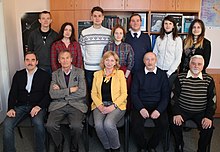
Sloboda Ukraine, or Slobozhanshchyna, is a historical region located in northeast Ukraine and southwest Russia. It developed and flourished in the 17th and 18th centuries on the southwestern frontier of the Tsardom of Russia. In 1765, it was converted into the Sloboda Ukraine Governorate.

Victor Mishalow is an Australian-born Canadian bandurist, educator, composer, conductor, and musicologist.
Ukrainian Physicists' Tournament for University Students is a creative team competition of university students targeted to realize their potential through solving complicated scientific problems and defending their research projects in a scientific discussion, called Physics Fight. Is a part of International Physicists' Tournament.
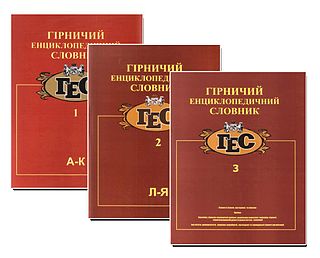
The Mining Encyclopedia is a Ukrainian language comprehensive set of encyclopedias about the science and technology of mining. The encyclopedias were compiled by more than 100 of the leading earth scientists in Ukraine and overseas, headed by Volodymyr Biletskyy.

Nikolai Bartossik is a Ukrainian-American contemporary painter and monumental artist.
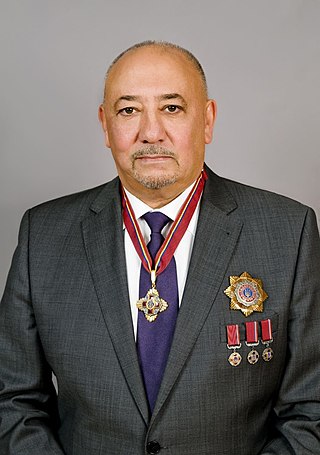
Yevgeny Lvovych Streltsov is a Ukrainian scientist and specialist in law and theology. He is Doctor of Law Sciences, Doctor of Theology, Professor, Corresponding Member of the National Academy of Legal Sciences of Ukraine, Honored Scientific Worker of Ukraine; Holder of 11 state awards, including: the Order of Merits of Ukraine of the 1st, the 2nd and the 3rd degrees, the insignia of the President of Ukraine – Medal “Twenty Years of Ukraine’s Independence, a son of Ukrainian law researcher Lev Streltsov.
Ternopil Volodymyr Hnatiuk National Pedagogical University is a university located in Ternopil, Ukraine.

H.S. Skovoroda Kharkiv National Pedagogical University is a Ukrainian university in Kharkiv. It was founded in 1933.

Kharkiv National University of Arts named after I. P. Kotlyarevsky is the leading music and drama institution of higher education in Ukraine. The university trains about 900 undergraduates, graduates and postgraduates in music and theatre art. It enjoys Level IV accreditation, which is the highest under Ukraine's national standards, and is licensed to train foreign students.

The School of Physics and Technology is one of the four physics schools of the V. N. Karazin Kharkiv National University. It specializes in the fields of theoretical physics, nuclear physics, plasma physics, materials science and medical physics. Distinctive features of the school include close cooperation with the Kharkiv Institute of Physics and Technology, and fundamental theoretical training in style of the Landau school, to which many instructors of the faculty belong.
Yuriy G. Shkuratov is a Ukrainian astronomer, specialist in the theory of light scattering by planetary surfaces. Corresponding member of the National Academy of Sciences of Ukraine (2012), winner of the State Prize of the Ukrainian SSR in Science and Technology (1986). Director of the Institute of Astronomy of Kharkiv National University (2004-2014), head of the Department of Astronomy and Space Informatics of Kharkiv National University.
Irina Belskaya is a Ukrainian astronomer, specialist in spectroscopy and polarimetry of Small Solar System bodies, head of the Department of Physics of Asteroids and Comets of the Institute of Astronomy of Kharkiv National University, recipient of the State Prize of Ukraine in Science and Technology (2010).

Vadym Kaydash is a Ukrainian astronomer, specialist in spectroscopy and polarimetry of Small Solar System bodies, director of the Institute of Astronomy of Kharkiv National University, recipient of the State Prize of Ukraine in Science and Technology (2010).

Vasilij G. Shevchenko is a Ukrainian astronomer, specialist in asteroid photometry, professor at the Department of Astronomy and Space Informatics of Kharkiv University. In 2012, he was awarded M. P. Barabashov Prize, the principal prize of the National Academy of Sciences of Ukraine for Solar System research.

Dmitriy G. Stankevich is a Ukrainian astronomer, specialist in computer modeling of light scattering by regoliths of planets and the Moon, as well as in digital processing of astronomical images. Winner of the State Prize of the Ukrainian SSR in Science and Technology (1986).
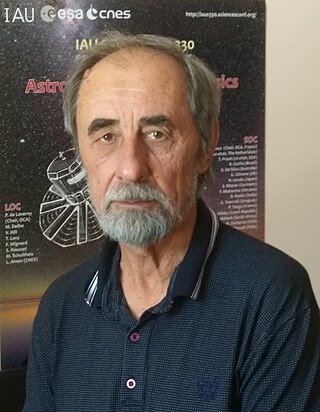
Peter N. Fedorov is a Ukrainian astronomer, specialist in astrometry and Galactic dynamics, known for his work on compiling the XPM star catalogue and determining the inertial coordinate system in the Milky Way. Head of the head of the Laboratory of Astrometry at Kharkiv Observatory, professor of the Department of Astronomy and Space Informatics at the V. N. Karazin Kharkiv National University. Winner of the Ye. P. Fedorov prize of the National Academy of Sciences of Ukraine for the series of works "Catalogues of stellar data as tools for astronomical research".
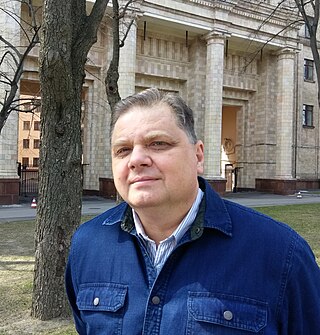
Igor O. Girka is a Ukrainian physicist and specialist in plasma physics. He is the dean of the School of Physics and Technology of Kharkiv National University, a Corresponding Member of the National Academy of Sciences of Ukraine, and a laureate of the K. D. Sinelnikov prize of the National Academy of Sciences of Ukraine (2010). He conducts research in plasma physics, nuclear fusion, and plasma electronics.
Kharkiv University History Museum is one of the first history museums created at a higher educational institution in Ukraine. It is located on the second floor of the main building of V. N. Karazin Kharkiv National University.

Olena Oleksiivna Lytovchenko was a Ukrainian writer and a metallurgical engineer by education. She wrote and co-authored with her husband Timur Litovchenko adventures, historical fiction, and detective fiction which books were published in Ukraine.

Marylivka former khutor in Ukraine, now part of the village of Nahirianka, Chortkiv Raion, Ternopil Oblast, Ukraine.

